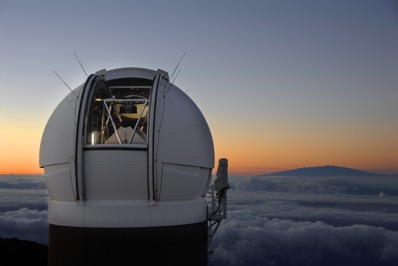


|

|
 |
|
Pan-STARRS scoops 19 asteroids in one night DR EMILY BALDWIN ASTRONOMY NOW Posted: 28 February 2011 The Pan-STARRS PS1 telescope (Panoramic Survey Telescope and Rapid Response System) clocked 19 near-Earth asteroids during the night of 29 January, setting a record for the most number of asteroids discovered in one night.  Richard Wainscoat (left) and Marco Micheli study one of the near-Earth asteroids found on January 29. The asteroid is the roundish dot near WainscoatÕs finger. IfA photo by Karen Teramura. The observation team initially identified 30 possible asteroid candidates, but in order for them to be confirmed, they must be re-observed several times within 12-72 hours. This enables astronomers to track them against the background stars to determine their orbits, before they move too far away to be seen again. Nineteen asteroids were confirmed in total. “This record number of discoveries shows that PS1 is the world’s most powerful telescope for this kind of study,” says Nick Kaiser, head of the Pan-STARRS project. “NASA and the U.S. Air Force Research Laboratory’s support of this project illustrates how seriously they are taking the threat from near-Earth asteroids.”  Pan-STARRS PS1 Observatory just before sunrise on Haleakala, Maui. Image: Rob Ratkowski. The initial discoveries were sent to the Minor Planet Center which collects and disseminates data about asteroids and comets so that other astronomers can re-observe these objects. As well as mainland telescopes, astronomers located in Italy, Japan, the United Kingdom, and the Faulkes Telescope on Haleakala helped to confirm the discoveries. Pan-STARRS is a 1.8 metre facility in Hawaii and is deemed to be the front line of Earth defence, scanning the sky every night with the world's largest digital camera that boasts 1,400 megapixels. As well as asteroids and comets, the telescope will also catalogue supernovae, quasars and stars as it maps one-sixth of the sky every month. It detected its first potentially hazardous asteroid in September 2010 (read more here). |
|
|
|
|